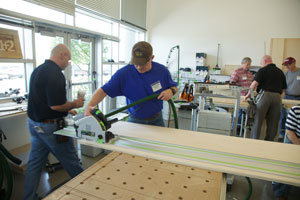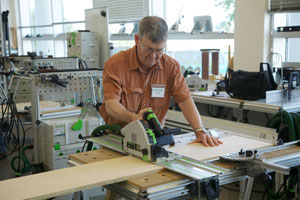
Festool is a German manufacturer of very well designed and rugged portable power tools. Their market is the high-end finish carpenter as well as the professional who wants to either site- or shop-build custom cabinets.
Earlier this year, I had the pleasure of attending Festool’s Cabinet Class in Lebanon, Indiana. Festool regularly runs intensive classes that teach the utility of their tools both in Lebanon and at a second facility in Las Vegas, Nevada. Other classes are: Drawer and Door Construction and Farm Table Workshop. At $250 for a two-day workshop or $500 for a five-day sojourn, the classes are very reasonably priced. The program is so successful that classes sell out within a couple hours of posting on the Festool website.
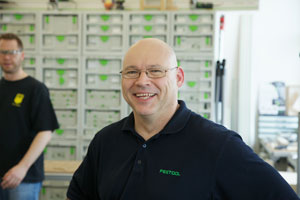
The class I attended was taught by Brian Sedgeley, who is a knowledgeable, charismatic instructor who brings tremendous energy to the classroom. The cabinet class is aimed at anyone wanting to build kitchen cabinets in theEuro, or 32mm, system which evolved just after World War II. It is based on increments of 32mm, because this was the minimum spacing possible of two spindles in a line-boring machine at that time. All hardware is based on this distance, so hinges mount in two holes spaced 32mm apart or a 35mm diameter blind hole. Shelf supports also go in 5mm diameter blind holes spaced 32mm apart, which at just over 1-1/4″ gives good adjustment.
Today, we are pretty much forced to build kitchen cabinets in the Euro System because of all the nifty 32mm hardware available — self/soft close, total adjustment of the door, amazing hinges, etc. The problem for a small shop is that kitchen cabinets are an industrial commodity made with high production CNC machinery. Festool offers small shops and high-end carpenters who want to make cabinets on a low production basis some great solutions.
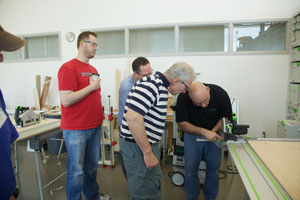
Each day was intensive, with students working full days in teams of two to actually build an upper and lower cabinet. We used a track saw to cut the stock and a router in conjunction with a special track that has holes on 32mm spacing to bore all the holes. The track, which I dubbed “the holey rail,” allows the router to bore the holes as accurately as a CNC machine. We sanded our cabinets with ROTEX sanders and mounted the hardware with drill drivers.
Something that has attracted me to Festool is that every tool has a port that easily couples to their extensive line of tool-triggered HEPA vacuums―which they call dust extractors. The amount of shavings that end up on the floor varies between tools. Waste pickup for their newest track saw, the TS 55 REQ, is 98 percent. Routers do not do as well, but even with this messy tool all of the fine dust is sucked up with only some of the larger shavings ending up on the floor.
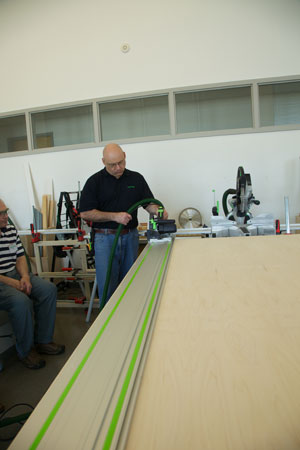
I feel the class gave me everything I came to learn. I can now make top-notch Euro cabinets on a low production basis. Any workshop has the tip or trick that makes you think, “oh, wow, that was worth the price of admission.” Brian sprung such serendipitous moments on us frequently! The cabinets we built were donated to housing initiatives in Third World countries, which put a really positive spin on our labors.
As part of my visit, I interviewed Michael Williams who is vice president of marketing. What follows is that Q & A session.
Q: Michael, who does Festool see as its target customer?
A: Ernie, we build our tools for the professional and have developed a loyal following amongst top craftsmen.
Q: But I talk to many amateurs who are Festool enthusiasts.
A: Yes, but we build for the professional. I fully realize there are many hobbyists who are top-notch woodworkers, better than many professionals. They buy our tools for the same reasons that professionals do: rugged tools that work, outstanding customer service and pride in owning the best.
Q: As far as I know, ALL Festools incorporate dust extraction. How long has Festool made dust extraction a priority, and what has it taken engineering wise to make this possible?
A: Though I can’t tell you the exact date on which Festool decided to make dust extraction the backbone of the system, I can tell you that we began pioneering solutions long before any other manufacturer gave it a second thought. And yes, other than a couple tools like drills or flashlights, virtually every single tool we design starts with dust extraction as a first priority.
Q: Michael, I have been very impressed by your school. Above the very good and useful training, I got to see your warehouse and repair center. Just seeing the technicians working on your tools makes me feel good about using them. Tell our readers a little more about Festool repair philosophy.
A: Really, it’s not so much that repair is a huge issue for our customers at large, since our tools just don’t break down that often. What’s more important is that customers want to be assured that, in the event their tool actually does break down, it will be out of their hands for only a couple of days. We’ve built a great reputation not only for fast turnaround, but for being transparent and responsive throughout the process. People know that when they send their tools in, they’re going to get them back quickly and with no surprises.
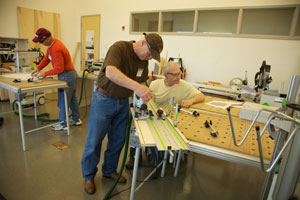
Q: Tell me a little about the Festool School program and the philosophy behind it.
A: Training has been at the heart of the Festool program since we started doing business in the U.S., though only in the last few years has this shifted from dealer training to end-customer training. At the most basic level, when you invest in a Festool, you’re going to get a solution that saves you time and increases your quality of work. Once you understand the system at a deeper level, the benefits are exponential. What we’ve discovered is a tremendous hunger among end users to learn as much about our tools and their applications as possible, in a short period of time, hence the application-focused classes.
Q: Are there any plans to expand the school program to other venues or take it to a video training format?
A: We are constantly looking for opportunities to get more educational content out to not only our end users, but to the power tool using population in general, who may not be using Festool currently, but have a problem, and are looking for a solution. At this point, we’re looking at all options to make this happen.

Q: Are there any new courses in the works?
A: We’ve recently introduced a Furniture Techniques class, based on the construction of a farm table, and we’ll soon introduce a Trim Carpentry class. We are constantly looking for ways to keep the content fresh, while developing an overall program that’s well-suited to our target customers.
Q: Are there any new tools in the pipeline that you can tell us about at this time?
A: We’ve just recently launched the TS 55 REQ, the long-awaited update to our game-changing platform of rail-guided saws. In September, we’ll launch the all-new Carvex jigsaw, a tool that will completely reset people’s expectations for how a jigsaw should perform. All of this is followed later in the year by quite a few additions to our line-up of organization and mobility solutions. And trust me, there’s plenty more to come in 2014.
